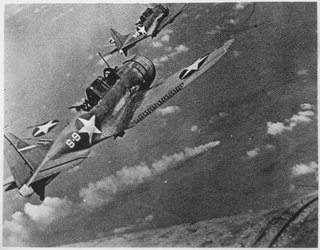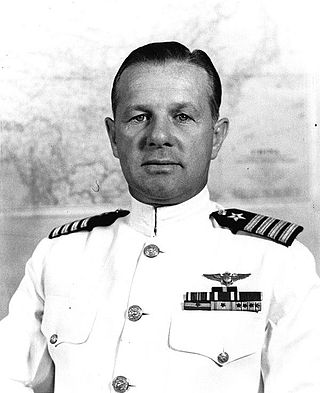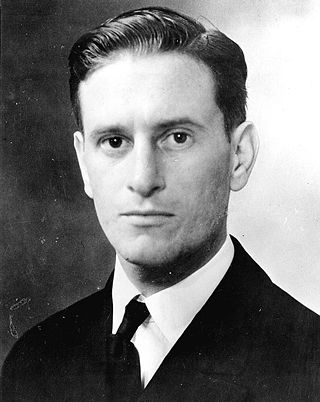
The Battle of Midway was a major naval battle in the Pacific Theater of World War II that took place 4–7 June 1942, six months after the Empire of Japan's attack on Pearl Harbor and one month after the Battle of the Coral Sea. The U.S. Navy under Admirals Chester W. Nimitz, Frank J. Fletcher, and Raymond A. Spruance defeated an attacking fleet of the Imperial Japanese Navy under Admirals Isoroku Yamamoto, Chūichi Nagumo, and Nobutake Kondō north of Midway Atoll, inflicting devastating damage on the Japanese fleet. Military historian John Keegan called it "the most stunning and decisive blow in the history of naval warfare", while naval historian Craig Symonds called it "one of the most consequential naval engagements in world history, ranking alongside Salamis, Trafalgar, and Tsushima Strait, as both tactically decisive and strategically influential."

USS Enterprise (CV-6) was a Yorktown-class carrier built for the United States Navy during the 1930s. She was the seventh U.S. Navy vessel of that name. Colloquially called "The Big E", she was the sixth aircraft carrier of the United States Navy. Launched in 1936, she was one of only three American carriers commissioned before World War II to survive the war. She participated in more major actions of the war against Japan than any other United States ship. These actions included the attack on Pearl Harbor — 18 Douglas SBD Dauntless dive bombers of her air group arrived over the harbor during the attack; seven were shot down with eight airmen killed and two wounded, making her the only American aircraft carrier with men at Pearl Harbor during the attack and the first to sustain casualties during the Pacific War — the Battle of Midway, the Battle of the Eastern Solomons, the Battle of the Santa Cruz Islands, various other air-sea engagements during the Guadalcanal Campaign, the Battle of the Philippine Sea, and the Battle of Leyte Gulf. Enterprise earned 20 battle stars, the most for any U.S. warship in World War II, and was the most decorated U.S. ship of World War II. She was also the first American ship to sink a full-sized enemy warship after the Pacific War had been declared when her aircraft sank the Japanese submarine I-70 on 10 December 1941. On three occasions during the war, the Japanese announced that she had been sunk in battle, inspiring her nickname "The Grey Ghost". By the end of the war, her planes and guns had downed 911 enemy planes, sunk 71 ships, and damaged or destroyed 192 more.

USS Hornet (CV-8), the seventh U.S. Navy vessel of that name, was a Yorktown-class aircraft carrier of the United States Navy.

Samuel Adams was an officer in the United States Navy decorated for action in the Battle of Midway during World War II.

The Battle of the Santa Cruz Islands, fought during 25–27 October 1942, sometimes referred to as the Battle of Santa Cruz or Third Battle of Solomon Sea, in Japan as the Battle of the South Pacific, was the fourth aircraft carrier battle of the Pacific campaign of World War II. It was also the fourth major naval engagement fought between the United States Navy and the Imperial Japanese Navy during the lengthy and strategically important Guadalcanal campaign. As in the battles of the Coral Sea, Midway, and the Eastern Solomons, the ships of the two adversaries were rarely in sight or gun range of each other. Instead, almost all attacks by both sides were mounted by carrier- or land-based aircraft.

USS Harold J. Ellison (DD-864) was a Gearing-class destroyer in service with the United States Navy from 1945 to 1983. She was then transferred to Pakistan and renamed Shah Jahan (D-164). The ship was finally sunk as a target in 1994.

USS Northampton (CL/CA-26) was the lead ship in Northampton-class cruiser, in service with the United States Navy. She was commissioned in 1930, originally classified a light cruiser because of her thin armor but later reclassified a heavy cruiser because of her 8-inch guns. During World War II she served in the Pacific and was sunk by Japanese torpedoes during the Battle of Tassafaronga on 30 November 1942. She was named after the city of Northampton, Massachusetts, the home of former President Calvin Coolidge.

USS John C. Butler (DE-339) was the lead ship of her class of destroyer escorts in the service with the United States Navy from 1944 to 1946. She was recommissioned between 1950 and 1957 and finally sunk as a target in 1971.

Rear Admiral Clarence Wade McClusky, Jr., was a United States Navy aviator during World War II and the early Cold War period. He is credited with having played a major part in the Battle of Midway. In the words of Admiral Chester Nimitz, McClusky's decision to continue the search for the enemy and his judgment as to where the enemy might be found, "decided the fate of our carrier task force and our forces at Midway".

USS Hart (DD-594), a Fletcher-class destroyer, was the second ship of the United States Navy of that name, in honor of Lieutenant Patrick H. Hart (1912–1942), who posthumously received the Navy Cross for heroism during the Battle of Midway.

USS Massey (DD-778), an Allen M. Sumner-class destroyer, was a United States Navy ship that served between 1944 and 1973.

Ralph McMaster Rich was an aviator of the United States Navy during World War II.
John Thomas Eversole graduated from the United States Naval Academy in 1938, and after duty at sea received aviation training. On May 7, 1941, Eversole joined Torpedo Squadron 6 (VT-6) in USS Enterprise (CV-6), and with many others of his squadron, gave his life for his country in the opening phases of the Battle of Midway 4 June 1942, in an attack on Japanese carriers made through heavy opposition. Lieutenant Eversole's determination in this action was posthumously recognized with the award of the Navy Cross.

Eugene Elbert Lindsey was an officer and aviator in the United States Navy. He is the namesake of the destroyer USS Lindsey (DD-771).
William Bowen Ault was a commander in the United States Navy during World War II and a posthumous recipient of the Navy Cross. The front page of the June 18, 1942, issue of the Enterprise Chieftain carries the news of Commander William Ault's death in the Pacific.

USS Haas (DE-424) was a John C. Butler-class destroyer escort acquired by the U.S. Navy during World War II. The primary purpose of the destroyer escort was to escort and protect ships in convoy, in addition to other tasks as assigned, such as patrol or radar picket.

USS Oswald A. Powers (DE-542) was a United States Navy John C. Butler-class destroyer escort launched during World War II but never completed.

USS Henry R. Kenyon (DE-683) was a Buckley-class destroyer escort in service with the United States Navy from 1943 to 1947. She was sold for scrap in 1970.
George M. Campbell was a United States Navy officer. He was killed in action at the Battle of Midway while flying a torpedo bomber during an attack against several Japanese aircraft carriers.

Lance Edward "Lem" Massey was a U.S. Navy pilot during World War II.
















